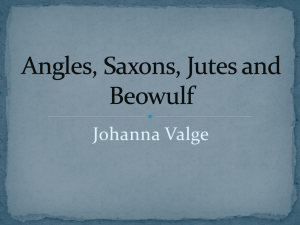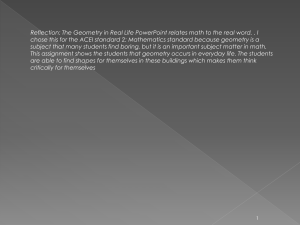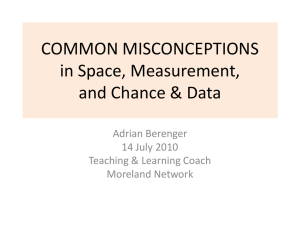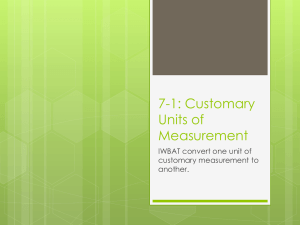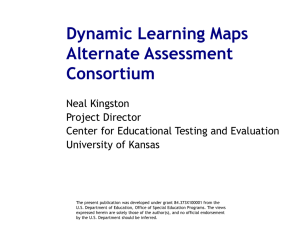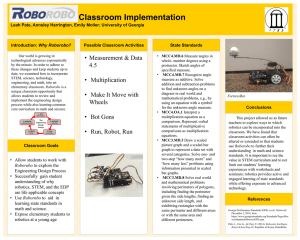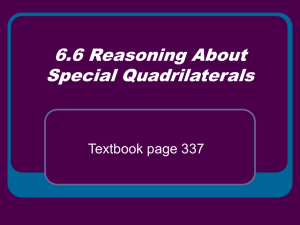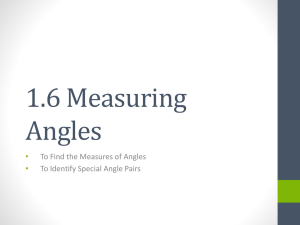Geometry Around Us
advertisement
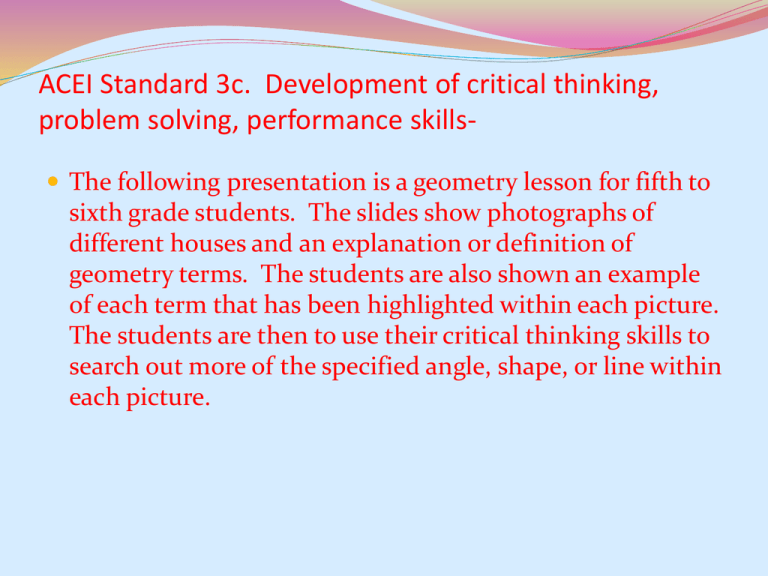
ACEI Standard 3c. Development of critical thinking, problem solving, performance skills The following presentation is a geometry lesson for fifth to sixth grade students. The slides show photographs of different houses and an explanation or definition of geometry terms. The students are also shown an example of each term that has been highlighted within each picture. The students are then to use their critical thinking skills to search out more of the specified angle, shape, or line within each picture. Geometry Around Us By Danielle LeoGrande All pictures taken near Syracuse, NY Directions •This is your geometry workbook. Each page contains definitions and illustrations of key geometry concepts (ideas). •After reading the definitions and looking at the examples you are to go hunting for more of the same geometric ideas that are hidden in the picture. •Use a crayon or colored pencil to trace or highlight each geometric idea that you find. •Remember to be creative and think outside the box. •Happy hunting! Some of the important geometric ideas that you will be searching for are: •Lines •Angles •Triangles •Quadrilaterals •Other polygons •And much more… Parallel Lines Parallel lines are lines that run in the same direction and will never meet. The distance between the lines is fixed, which means that it never changes. Here is an example of parallel lines. Can you find more parallel lines? Intersecting Lines Intersecting lines are lines that meet at a single point. When the lines intersect (meet) angles are formed. Here is an example of intersecting lines. Can you find more intersecting lines? Perpendicular Lines Perpendicular lines are lines that intersect at a point to form a 90° angle. All perpendicular lines are intersecting lines, however not all intersecting lines are perpendicular. Here is an example of perpendicular lines. Can you find more perpendicular lines? Angles Acute angles measure less than 90°. Obtuse angles measure more than 90°. Right angles measure exactly 90°. Here are some examples of acute angles, obtuse angles and right angles. Can you find more acute angles, obtuse angles, and right angles? Congruent Angles Congruent angles are angles that have the same measurement. Congruent angles do not have to have the same orientation (do not have to be facing the same way). Here is an example of congruent angles. Can you find more congruent angles? Adjacent Angles Adjacent angles are angles that are right next to each other. Adjacent angles share one line segment. Here is an example of adjacent angles. Can you find more adjacent angles? Supplementary Angles Two angles are called supplementary if the sum of their angles is equal to 180°. Supplementary angles can be adjacent (next to each other), or they may not be adjacent (not next to each other). Here is an example of adjacent supplementary angles. Here is an example of supplementary angles that are not adjacent. Can you find more adjacent supplementary angles. Can you find more supplementary angles that are not adjacent? Complementary Angles Two angles are called complementary when the sum of their angles is equal to 90°. Complementary angles can also be adjacent or not adjacent. Here is an example of adjacent complementary angles. Here is an example of complementary angles that are not adjacent. Can you find more adjacent complementary angles? Can you find more complementary angles that are not adjacent? Triangles Right triangles have one angle that is equal to 90°. A triangle is acute if all of it’s angles are less than 90°. Obtuse triangles have one angle that is greater than 90°. Here are some examples of right triangles, acute triangles, and obtuse triangles. Can you find more right triangles, acute triangles, and obtuse triangles? Equilateral Triangles Equilateral triangles have three sides of equal length and three angles of equal measure. All angles of equilateral triangles measure 60°. Here is an example of an equilateral triangle. Can you find more equilateral triangles? Isosceles Triangles An Isosceles triangle has two sides of equal length and two angles of equal measure. The equal angles are always opposite the equal sides. Here is an example of an isosceles triangle. Can you find more isosceles triangles? Scalene Triangles A scalene triangle has three sides of different lengths and three angles of different measure. Here is an example of a scalene triangle. Can you find more scalene triangles? Polygons Polygons are closed figures that are made up of several line segments that are joined together. The sides do not cross, and exactly two lines meet at every vertex. Here are some examples of polygons. Can you find more polygons? Quadrilaterals Quadrilaterals are two dimensional, four sided polygons. Quadrilaterals have four internal angles. Here are some examples of quadrilaterals. Can you find more quadrilaterals? Parallelograms A parallelogram is a quadrilateral that has opposite sides that are parallel and of equal length. The opposite angles are also of equal measure. Here are some examples of parallelograms. Can you find more parallelograms? Rectangles A rectangle is a special parallelograms which has equal and parallel opposite sides. All of the rectangle’s angles are right angles. Here are some examples of rectangles. Can you find more rectangles? Square A square is a special rectangle that has four sides of equal lengths and four right angles. Here is an example of a square. Can you find more squares? Trapezoid A trapezoid is a four sided polygon that has exactly two parallel sides. Here is an example of a trapezoid. Can you find more trapezoids? Other Polygons A pentagon is a polygon with five sides. A hexagon is a polygon with six sides. Here is an example of a pentagon. Here is an example of a hexagon. Can you find more pentagons? Can you find more hexagons? Other Polygons cont. Octagons are polygons that have eight sides. Here is an example of an octagon. Can you find more octagons? Convex Polygons A polygon is a convex polygon if a straight line drawn through it at any point crosses at most two sides. Every interior angle in a convex polygon is less than 180°. Here are some examples of convex polygons. Can you find more convex polygons? Concave Polygons A polygon is a concave polygon if you can draw at least one straight line through it that crosses more than two sides. Concave polygons have at least one interior angle that is greater than 180°. Here are some examples of concave polygons. Can you find more concave polygons? Symmetric Polygons Symmetric polygons have the quality that when they are bisected into two congruent parts, each point on one side of the line of symmetry (bisection line) will have a reflective point on the other side of the bisection line. Here are some examples of symmetric polygons. Can you find more symmetric polygons? Non-Symmetric Polygons When bisected, a non – symmetric polygon does not have a reflective point for every point across the line of symmetry (bisection line). Here are some examples of non-symmetric polygons. Can you find more nonsymmetric polygons? Translation When an object is translated, all of the points in the object are moved in a straight line in the same direction. Size, shape, and orientation (direction the object faces) all stay the same. The object “slides” from one place to another. Here is an example of a translated object. Can you find more translated objects? Reflection When an object is reflected, all points of the object are reflected or “flipped” over a line called the axis of reflection. The reflected object looks backwards or reversed from the original. Here is an example of a reflected object. Can you find more reflected objects? The next time you are walking down your street, sitting in your classroom, or playing on the playground take a look around you. Shapes are everywhere and in everything. They are not always obvious, sometimes you have to take a good look. After a little practice, finding the geometry in your day to day life will be a breeze… Differentiation It is the teacher’s responsibility to ensure that every child’s learning challenges are accommodated for. Teachers can accommodate for learning challenges by changing any number of things such as lesson content, lesson process, student’s expected output, or the learning environment. Children that have difficulty with fine motor skillsTeachers can show these students the photographs and then the students can illustrate the geometric concept that they see by using the geoboards from the http://www.nlvm.usu.edu/ web page or from http://www.mathclub.com/download/download.html. Children that are visually impairedThese students can be given shapes traced with glue on construction paper and be asked to color in the shapes. They can the pick the corresponding shape out of a basket full of blocks that correlate to the geometric concepts in the lesson. Lines I would like the students to be able to differentiate between parallel, perpendicular, and intersecting lines. The students should also understand that all perpendicular lines are intersecting, but all intersecting lines are not perpendicular. Angles I would like the students to be able to differentiate between acute, right, obtuse, and straight angles. The students should also be able to identify what it means for angles to be congruent, adjacent, complementary, and/or supplementary. Triangles I would like the students to be able to compare and contrast triangles. The students should understand that triangles, like angles, can be acute, right, or obtuse. The children should also be able to compare and contrast isosceles triangles, equilateral triangles, and scalene triangles. Students should understand that the measure of all of the angles of a triangle add up to 180°. Quadrilaterals I would like the students to be able to compare and contrast quadrilaterals so that they will know and understand the individual properties of the most common quadrilaterals. The students should be able to identify squares, rectangles, rhombuses, parallelograms, and trapezoids. Other Polygons I would like the students to understand the difference between convex and concave polygons. The students should also be able to identify polygons that are symmetric or non-symmetric. The students should be able to identify and name other polygons, recognizing that their names are related to the number of sides and angles that are present. Rigid Transformations I would like for the students to be able to understand and illustrate the properties of translation, rotation, and reflection. The students should be able to speak to each transformation and be able to compare and contrast the way each object looks after it has been transformed in some way. The students should realize that transforming the object does not change the perimeter, length, or area of the object. Relationships The final thing that I would like for the students to develop is a relationship between all of the concepts that we have discussed in the lesson. I would like for the students to see a connection between all of these geometric concepts and to also be able to connect geometry with their every day lives. Standards 3.PS.5 Formulate problems and solutions from everyday situations 3.PS.12 Use physical objects to model problems 3.G.1 Define and use correct terminology when referring to shapes (circle, triangle, square, rectangle, rhombus, trapezoid, and hexagon) 3.G.2 Identify congruent and similar figures 3.G.5 Identify and construct lines of symmetry 4.PS.11 Make pictures/diagrams of problems 4.CM.5 Share organized mathematical ideas through the manipulation of objects, drawings, pictures, charts, graphs, tables, diagrams, models, symbols, and expressions in written and verbal form 4.CM.10 Describe objects, relationships, solutions, and rationale using appropriate terminology 4.CN.6 Recognize the presence of mathematics in their daily lives 4.R.4 use standard and non-standard representation with accuracy and detail 4.R.5 Understand similarities and differences in representations Standards (cont.) 4.G.1 Identify and name polygons, recognizing that their names are related to the number of sides and angles (triangle, quadrilateral, pentagon, hexagon, and octagon) 4.G.2 Identify points and line segments when drawing a plane figure 4.G.6 Draw and identify intersecting, parallel and perpendicular lines 4.G.8 Classify angles as acute, right, obtuse, or straight 5.CM.9 Increase their use of mathematical vocabulary and language when communicating with others 5.G.2 Identify pairs of similar triangles 5.G.4 Classify quadrilaterals by properties of their angles and sides 5.G.6 Classify triangles by properties of their angles and sides 5.G.9 Identify pairs of congruent triangles 5.G.11 Identify and draw lines of symmetry of basic geometric shapes
